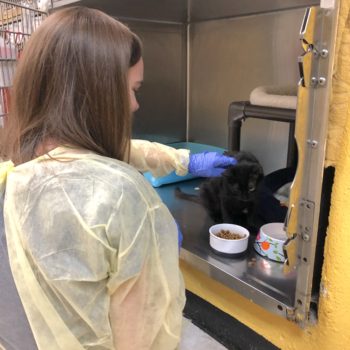Emergency foster care initiatives can be a game-changer when an organization or one of its partners is in crisis. Quickly sending pets to foster homes at these crucial times can save lives, but the messaging can be tricky. Emergency foster pleas need to be urgent enough to motivate the community to act, but too much negativity in the messaging can put your organization under fire from the public and damage relationships with your partners.
Luckily, it is possible to create messaging that conveys urgency while avoiding unnecessary negativity. Here are some strategies that can help you do this:
Avoid blaming or criticizing. If you’re transferring pets in from another organization in crisis, stress that the organization is your partner and that they’ve asked you for help because they care about their pets.
Post photos or video of individual animals needing foster and/or the extent of the crisis (i.e., crates of dogs lined up in your training room or photos of flooding in the town where the hurricane hit). These photographs and videos can make emotional connections with your supporters, motivating them to act. You can use Facebook Live to make a live plea.
Help the community understand background factors unique to animal sheltering. For example, upper respiratory infections (URI) in shelters can put kittens’ lives at risk, but the majority of the public thinks of a URI as something minor. If their kitten gets one, they generally go to the vet, get medicine and their kitten recovers. Most people don’t realize that URIs in shelters are much different for kittens because of their immature immune systems, the effect shelter stress has on their bodies and limited isolation space. When we know something, we tend to think others know it as well. Explaining some of these background factors can help the public understand the situation while adding urgency to your plea.
Use details to help your community grasp the scale of the crisis. “We’re full” sounds vague.
Telling your supporters that your staff meeting was held in the lobby because the crates of a dozen dogs were in the conference room does not. This can motivate them to act.
Tell supporters about the things your organization (or the organization in crisis) is doing to alleviate the problem. Are you turning an area of your shelter into a makeshift isolation area to contain an outbreak? Handing out frozen Kongs and ice cubes while your air conditioning is broken? This lets the community know you’re doing your very best while making it clear that you still need their help.
Pima Animal Care Center, a high-intake shelter in Tucson, Arizona with a live release rate of over 90%, utilizes emergency foster several times a year during crises such as population spikes and outbreaks of contagious illness. “Emergencies happen, and the public understands but you have to walk a fine line,” says Nikki Reck, PACC’s Public Information Officer. “The good news is that people love to help. When you have a true crisis happening, tell them exactly what you need. Mainly, you want to avoid any sort of language that places blame.” Below is the text from a recent Facebook post:
Yesterday, we took in 89 pets. Today, we already have 5 that have been dropped off and we aren’t even open yet. Historically, the next two weeks are when we have our highest, overall number of animals in the shelter. We can expect to house 800 or more pets at PACC through mid-October when the population SLOWLY starts to decrease. We aren’t exactly sure the reason for this, but the biggest factor seems to be that adoptions/foster decrease during this time because people are busy with fall plans and kids going back to school. We are working to increase co-housing for dogs and we really need fosters for just about everything right now. If you can foster, even for just a few weeks, please email PACC.foster@pima.gov. It is a huge help to clear some kennels for incoming pets. If you have been thinking about adopting, now truly is the time.
The shelter conveys urgency in a positive way by including details such as the number of pets currently at the shelter and the fact that they’re increasing co-housing for dogs to explain to the community what the crisis means for shelter staff and pets. The public probably doesn’t know that it’s the time of year when their shelter’s population is typically at its highest; telling them helps to understand some of the factors in the background that are causing the emergency.
We’ll be posting a document containing several text templates that your organization can use to get the word out about emergency foster initiatives in Maddie’s Pet Forum.

